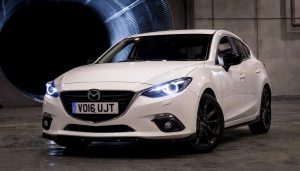Midsize Car: 2012 Honda Accord – $12,000
This car was very popular when it was new, and critics admired it for its unusually spacious interior considering its class, and its agile handling. The base LX version is powered by a four-cylinder engine EPA-rated at 22 MPG in city driving, and 34 on the highway. It’s also a gas sipper, which is an important quality given a teenager’s limited operational budget. It comfortably seats five people and is a favorite for its overall combination of polish, refinement, and efficiency.
Safety wise, the Accord looks a lot like the Subaru Forrester:
- The National Highway Traffic Safety Administration (NHTSA) conducts crash tests and awards stars with 5 stars being the top rating. The 2012 Honda Accord earned a 5 star rating.
- ABS anti-lock braking system.
- Air bags. Lots of them. Front collision, side collision, front and rear air bags.
- 4-wheel disc brakes.
- Brake assist.
- Electronic stability control.
- Traction.
- Daytime running lights to give other drivers a heads up.
Pickup: 2007 Toyota Tundra Double Cab – $12,000
The only reason a pickup has made the list because 14% of teens drive one. Just like the rest of America, teens love them some pickup trucks. Of course, you may find yourself in the position of asking your kid if you can borrow the keys to their truck because you’ve got stuff to haul, or a toy to tow. The 2007 Tundra was designed to directly compete with Ford, Chevy, and Ram. The interior is big for a crew cab, and provides lots of room for five passengers. The commodious console is large enough to house a laptop. The V-6 engine in the base model is rated for 15 MPG in city driving, and 19 on the highway. There is a V8 but it’s downright pricey, as well as off-road tempting.
Electronic stability control (ESC) has been required on all vehicles since 2012. The 2007 Toyota Tundra is one of the few vehicles that had it as a standard five years before it became the law. As far as pickups go, the 2007 Tundra is one of the best. Let’s take a look at what it has safety wise:
- Stability control. Even though it is an early edition of this safety feature, it is still effective.
- Air bags. Front, side, and overhead protection.
- Pretensioners. Seatbelt automatically tighten to place the occupant in the optimal seating position during a collision.
- Anti-lock ABS brakes for all four wheels.
Economy Sedan: 2011 Mazda 3 – $5,450
Normally you wouldn’t find a compact car on a list like this, but the 2011 Mazda 3 is a Consumer Reports recommendation for a safe, affordable ride for a teenage driver. Like Toyota, Mazda has an excellent reputation in preventive and reactive safety features. This is the closest thing to a “sports car” on the list so it’s an easy sell to a kid. The base comes with 2.0-liter inline-4 that produces 148 horsepower, and a 25 mpg combined EPA rating. A 5-speed stick transmission is standard but there is a 5 speed automatic available as well. The interior is almost too nice to waste on a teenager’s propensity to eat greasy food in the car. The Mazda 3 is a hit with the general public thanks to its pleasing driving demeanor, ample equipment, excellent quality, and choice of body styles. It pleases your Jinba Ittai (go ahead and Google it).
The 2007 Mazda 3 safety features include:
- Stability and traction control.
- Antilock disc brakes (with brake assist).
- Active front head restraints.
- Front side airbags and side curtain airbags.
- NHTSA 5 star crash test rating.
So there are five rides to consider when choosing a vehicle for the new driver in your family. If you are old enough to remember first cars being Corvairs, Pintos, or VW Bugs that were one step away from being converted to dune buggies, you can appreciate how far the industry has come.
As a general rule, make sure the vehicle you buy has key safety features like electronic stability control and curtain airbags. These systems are worth every penny they cost in an emergency situation. Remember, your teenager is inexperienced, and is more likely to need this gear than you are. If you can stretch the budget, find a model with forward-collision warning and automatic emergency braking.
Of course, there is the whole issue of the purchase being a used car. No two owners are alike. A car can be loaded with safety gear, but if the vehicle was poorly maintained, it represents a serious risk. Buying a used car is an art unto itself. We suggest you read our other articles on buying a used car so you can get the best results.
You, and your insurance agent, are about to enter a brave new world. The more you can afford to spend on safety, the better the odds for your teenager. But above all, your driving example and your concern for safety will be the most important “equipment” a teenager can have when they start to drive.








